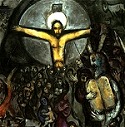|
THE STORY OF THE EXODUS from Egypt reveals that the nation of Israel was "born" by means of the blood of the Passover lamb. But the original Passover was a means to the revelation given at Sinai (ΧΦ·ΧͺΦΌΦΈΧ ΧͺΦΌΧΦΉΧ¨ΦΈΧ), and the revelation at Sinai found its ritual expression in a system that required the constant shedding of the blood of sacrificial animals (i.e., the Mishkan or "Tabernacle"). The Book of Leviticus is therefore the essence of the Torah given at Sinai. Thus we see the progression: Passover -> Sinai -> Tabernacle.
The word mishkan (ΧΦ΄Χ©ΧΦ°ΧΦΌΦΈΧ) comes from a root (Χ©ΧΦΈΧΦ·Χ) meaning "to dwell." This holy tent/compound was intended to provide a place of sacrifice and fellowship with the LORD God of Israel. Since the Mishkan represented God's dwelling place, it became associated with the Shekhinah (Χ©ΧΦ°ΧΦ΄ΧΧ ΦΈΧ), or manifest Presence of God Himself. This is particularly the case regarding the Ark of the Covenant (ΧΦΈΧ¨ΧΦΉΧ ΧΦΈΧΦ°Χ¨Φ΄ΧΧͺ) and its sacred cover called the "Kapporet" (ΧΦΌΦ·Χ€ΦΌΧ¨ΦΆΧͺ) located within the inner sanctum of the Holy of Holies (Χ§ΧΦΆΧ©Χ ΧΦ·Χ§ΦΌΦ³ΧΦΈΧ©ΧΦ΄ΧΧ). (Note that the term "Mercy Seat" comes from Martin Luther's translation of the Bible into German, where he added to the meaning of kapporet by translating it as a location or "seat" of mercy.) Upon the Kapporet were set two cherubim (ΧΦΌΦ°Χ¨Φ»ΧΦ΄ΧΧ) -- angel-like figures with open wings and baby faces. It was from between these faces that the LORD later directly spoke to Moses, it was here that sprinkled sacrificial blood would appeal to God's forgiveness during the appointed time of Yom Kippur. Thus we have the following progression: Passover -> [Sinai] -> Tabernacle -> | Holy Ark.
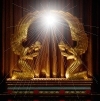
The Holy Ark symbolized the antithesis of the profane. It was situated in a veiled-off sacred space where God Himself would manifest in the form of the Shekhinah that dwelt (shachan) between the cherubim over the kapporet of the Ark. As such, it was utterly sacred and represented the Throne of God Himself in the midst of Israel. Thus we see the progression: Passover -> [Sinai] -> Tabernacle -> | [Holy Ark] -> Throne of God (i.e., the Ark was a means to God's Presence).
But note that the "medium of exchange" in all of this -- from the Passover to the Throne of God -- was the sacrificial blood of an innocent victim. The blood is the means of "at-one-ment" or reunion with God. As the Torah (Lev. 17:11) plainly states, "For the life of the flesh is in the blood (ΧΦΌΦ΄Χ Χ ΦΆΧ€ΦΆΧ©Χ ΧΦ·ΧΦΌΦΈΧ©ΧΦΈΧ¨ ΧΦΌΦ·ΧΦΌΦΈΧ), and I have given it for you on the altar to atone (ΧΦ°ΧΦ·Χ€ΦΌΦ΅Χ¨) for your souls, for it is the blood that makes atonement by the life (ΧΦΌΦ΄ΧΦΎΧΦ·ΧΦΌΦΈΧ ΧΧΦΌΧ ΧΦΌΦ·Χ ΦΌΦΆΧ€ΦΆΧ©Χ ΧΦ°ΧΦ·Χ€ΦΌΦ΅Χ¨)." This is the "korban principle" -- life for life -- that functioned as the underlying principle of the Torah's sacrificial system. Indeed, over 40% of the Torah's commandments -- 246 of the 613 -- concern details of this system. The Book of Leviticus is the essence of the Torah, and the essence of the Book of Leviticus is the revelation that "sacrificial blood makes atonement."
The Levitical sacrificial system was based on a daily calendar with regular sacrifices and rituals by means of which a Jew could experience a relationship with God. However no Jew could ever enter the Holy of Holies and expect to live, since God's absolute holiness and glory would consume him immediately. So how, then, could Israel come before the very Throne of God? Only through an appointed representative (i.e., "mediator") who came bearing the blood of atonement on behalf of the sins of Israel -- and only on an appointed day (Tishri 10), otherwise known as Yom Kippur (the "Day of Atonement"). Thus the progression goes: Passover -> [Sinai] -> Tabernacle -> | [Holy Ark] -> blood presented by a mediator before the Throne of God -> Presence of God.
It is important to remember that the detailed instructions for constructing the Tabernacle were "according to the pattern" (ΧͺΦΌΦ·ΧΦ°Χ Φ΄ΧΧͺ) given to Moses at Sinai (Exod. 25:9). In other words, the tent, the furnishings such as the Table of the Bread of Presence (ΧΦ·Χ©ΦΌΧΦ»ΧΦ°ΧΦΈΧ ΧΦΆΧΦΆΧ Χ€ΦΌΦΈΧ Φ΄ΧΧ), the golden Menorah (ΧΦ°Χ ΧΦΉΧ¨ΦΈΧ), the Bronze Altar for sacrifices (ΧΦ΄ΧΦ°ΧΦΌΦ΅ΧΦ· ΧΦ·Χ Φ°ΧΧ©ΧΦΆΧͺ), the vessels, and so on, were first shown to Moses before they were created. They were copies or "shadows" that were intended to prefigure the eternal reality of the Heavenly Tabernacle itself. The entire sacrificial system was metaphorical, if you will, and pointed to a deeper reality that transcended the earthly sphere. Even the yearly Yom Kippur ritual was never intended to remain into perpetuity but pointed to something more profound -- namely, the greater avodah of Yeshua, the Kohen Gadol of the New Covenant (Heb. 9). Indeed, if the older covenant had been sufficient to provide a permanent solution to the problem of our sin, there never would have been need for a new covenant to supersede it (Heb. 8:7).
Note that the original Passover sacrifice (korban Pesach) was not given to the Levitical priesthood as a sin offering since it preceded Sinai and the giving of the various laws concerning the sacrificial rites. In the same way, Yeshua's sacrifice was directed from Heaven itself by means of the prophetic office of Malki-Tzedek (ΧΦ·ΧΦ°ΧΦΌΦ΄ΧΦΎΧ¦ΦΆΧΦΆΧ§) - a higher order of priesthood (Gen. 14:18; Psalm 110:4; Heb. 7). Yeshua both offered Himself up as the "Lamb of God" that causes the wrath of God to (eternally) pass over those who personally trust in Him, just as He offered himself as the "Goat of God" whose blood was sprinkled in the Holy of Holies to cleanse us from sin and give us (everlasting) atonement. Understood in this way, we see the progression: Lamb of God -> Heavenly Tabernacle -> the blood presented by a Mediator before Throne of God -> the Presence of God. Yeshua is the "first and the last" (Χ¨Φ΄ΧΧ©ΧΧΦΉΧ ΧΦ·ΧΦ²Χ Φ΄Χ ΧΦ·ΧΦ²Χ¨ΧΦΉΧ) of the love of God.
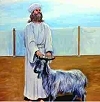
Yeshua as the "Lamb of God" pictures personal redemption from slavery to Satan and freedom from the wrath of God. This is the greater Passover/Exodus connection. By means of Yeshua's shed blood and broken body, the wrath of God "passes over us" and we are set free to serve God.... And Yeshua as the "Goat of God" pictures both personal cleansing (i.e., "propitiation" for our sins -- the Greek word (ἱλαΟΟὡΟΞΉΞΏΞ½) used for the kapporet that was sprinkled with the blood of the sacrifice on Yom Kippur) as well as national purification of ethnic Israel at the end of the Great Tribulation period. Upon the Messiah's ascension, the blood of his sacrifice was presented before the Throne of God, in the Holy of Holies "made without hands" (Heb. 9:11) for the soul's everlasting atonement before the Father:
For the Messiah has entered a Holiest Place which is not man-made and merely a copy of the true one, but into heaven itself, to appear now on our behalf in the Presence of God. Further, he did not enter heaven to offer himself over and over again, like the Kohen HaGadol who enters the Holiest Place year after year with blood that is not his own; for then he would have had to suffer death many times- from the founding of the universe on. But as it is, he has appeared once at the end of the ages to do away with sin through the sacrifice of himself. (Hebrews 9:24-26)
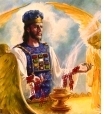
This is why Yeshua said to Miriam (i.e., Mary), "Touch me not; for I am not yet ascended to my Father" (John 20:17). Just as the (Levitical) Kohen Gadol offered the blood of the goat in the Holy of Holies in the Temple, so the heavenly priest (i.e., the word "priest" first occurs in the Torah regard Malki-Tzedek who offered bread and wine) needed to apply the blood upon the heavenly kapporet. This is the Yom Kippur connection.
Under the older covenant, sacrifices merely "covered" sins for a single year, but under the new covenant, these sins are taken entirely away (Hebrews 7:27, 9:12, 9:25-28). There is no more need for continual sacrifices, since Yeshua provided the once-and-for-all sacrifice for all of our sins (Hebrews 9:11-14; 9:24-28; 10:11-20). Indeed, Yeshua's sacrifice is called the "propitiation" or "expiation" for our sins -- the very same Greek word ("hilasterion") used in the Greek LXX for the kapporet [cover of the ark of the covenant] in the Holy of Holies that was sprinkled with the blood of the sacrifice on Yom Kippur.
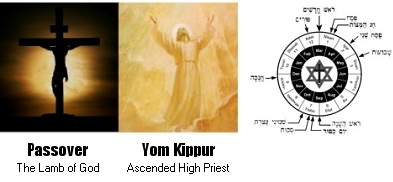 |
Yeshua's role as our great High Priest and Mediator gives us access to God! We can now come "boldly before the Throne of Grace" to seek mercy and help for our time of need. Because of the avodah of Yeshua, the parochet of the Temple has been rent asunder (Matt. 27:50) and we now have access to the Presence and love of God. Because of the atonement of Yeshua, we are given everlasting "chatimah tovah," a permanent "sealing" for good in the Book of Life (Eph. 1:13, 4:30; 2 Cor. 1:21-22). Bless His Holy Name forever!
|

